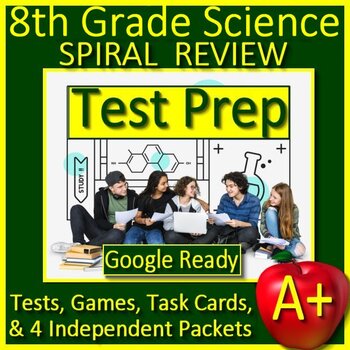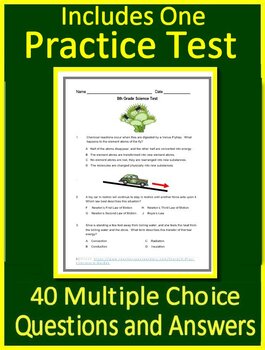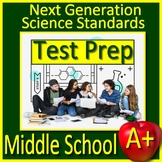8th Grade Science TEST PREP Bundle NGSS Units Print & SELF-GRADING GOOGLE FORMS!
- Zip
- Google Apps™
- Internet Activities

Products in this Bundle (7)
showing 1-5 of 7 products
Also included in
- Next Generation Science Test Prep: This HUGE bundle has EVERYTHING you need to cover the new Next Generation Science Standards for Middle School. ALL NGSS standards are covered using a variety of learning tasks. Perfect for test prep practice and NGSS spiral review. ALL of the practice tests are wrPrice $42.00Original Price $82.00Save $40.00
Description
This 8th grade science TEST PREP bundle contains learning packets, assessments, games, and task cards that cover the NGSS 8th grade science standards. All of the materials are printable AND Google Ready for Google Classroom. It even includes a 40 question final test that is written in SELF-GRADING GOOGLE FORMS!
NO NEED TO ADD TEXT BOXES - All of the work has already been done for you! Links for Google Docs have been provided, along with step by step directions for uploading to Google Classroom, and sharing with your students.
The 4 learning packets include Life, Physical, Earth and Engineering Design. There are a total of 80 questions and answers, which are PRINTABLE, but Google Links are also provided for use in Google Classroom. Perfect for Chromebooks, Laptops, Ipads, Desktops, etc.
The final test has 40 questions covering ALL of the standards. They are printable, but a link has also been provided for a SELF-GRADING GOOGLE FORM.
The game can be played competitively in school, but also can be played remotely at home for distance learning. Students can review these skills by themselves, or play with a family member or friend. They were created in PowerPoint format, and can easily be played with a PowerPoint reader. However, they can also be uploaded to Google Classroom, and opened in Google Slides for a fun Google Classroom Game! A tutorial for putting the game in Google Classroom and sharing with your students is included.
The task cards can be played in school, or emailed home for extra practice.
Includes a Review of ALL Units:
--Four Independent Learning Packets - Life, Physical, Earth and Engineering Design. A total of 80 questions and answers are included in Printable and Google Doc Format.
--Final Test - 40 multiple choice NGSS standardized test questions and answers
(Printable AND Self-Grading Google Forms)
--20 Task Cards - multiple choice NGSS questions and answers
--Science Game Show - 25 Questions and answers
The practice test, task cards, and games cover the following 8th grade NGSS Standards:
Life Science:
-Structure, Function, and Information Processing
-Matter and Energy in Organisms and Ecosystems
-Interdependent Relationships in Ecosystems
-Natural Selection and Adaptations
-Growth, Development, and Reproduction of Organisms
Earth and Space Science:
-Space Systems
-History of Earth
-Earth’s Systems
-Weather and Climate
-Human Impacts
Physical Science:
-Structure and Properties of Matter
-Chemical Reactions
-Forces and Interactions
-Energy
-Waves and Electromagnetic Radiation
Engineering Design
Next Generation Science Standards
Thank you and good luck on the test!
Why am I qualified to write these test prep questions? Not only have I worked as a teacher for 30 years with a Highly Qualified Status, but I also have spent 15 years writing state and national assessments, such as the SATs, ACTs, and individual state assessments that align with the Common-Core standards. This includes grading, item writing, and passage writing for these assessments.






